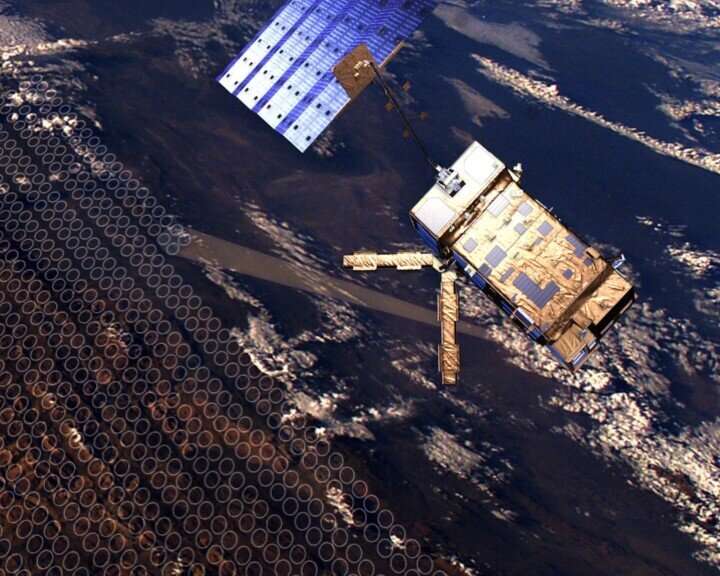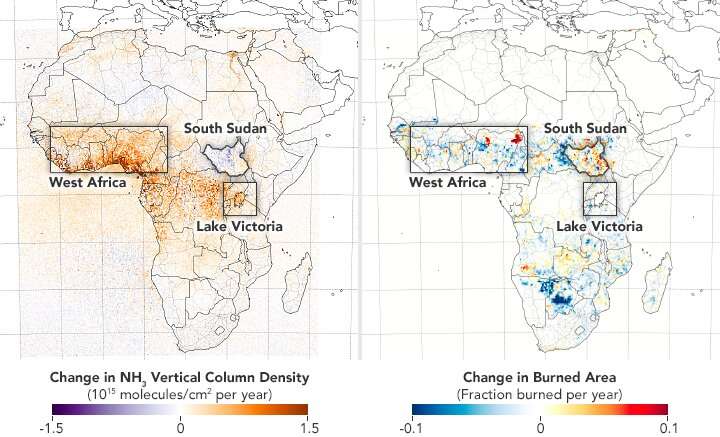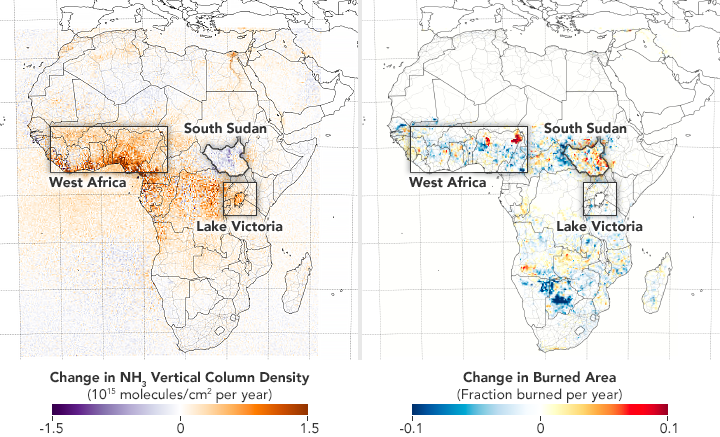A new NASA-led study is the first to document changing atmospheric ammonia (NH3) concentrations in Africa over an extended period. Ammonia is an air pollutant which can lead to heart and lung related illness. When present in excess in an ecosystem, it can make soil more acidic and hinder plant growth.
Ammonia is emitted naturally from soils and vegetation fires, but agricultural activities such as raising livestock and using fertilizer are also major sources. As agriculture scales up to meet the needs of growing populations, it is likely that ammonia emissions will rise too. To create this current view of ammonia emissions, the researchers used satellite data from 2008 to 2018, identifying rises and falls in ammonia concentrations across the continent and the likely causes of those changes.
“We’ve shown here that we can use satellite data to observe trends and monitor emissions of ammonia in specific regions, linked to specific activities or environmental events,” said Enrico Dammers, a scientist at the Netherlands Organization for Applied Scientific Research and co-author of the paper.
By 2050, the global population is expected to reach roughly 10 billion people. Africa’s population is predicted to be as much as 2.5 billion by then –– about double what it is today. In many African countries, governments are promoting fertilizer use to increase food production. In addition, biomass burning (the burning of living or dead vegetation), as a result of human and natural processes, is common in Africa, where about 70% of the global annual area of burned land occurs. These factors made Africa an important place to study ammonia emissions, according to principal investigator Jonathan Hickman, a research scientist at Columbia University and NASA’s Goddard Institute for Space Studies in New York City.

Using Infrared Atmospheric Sounding Interferometer (IASI) data, scientists can estimate how much of the Sun’s radiation is being absorbed by specific gases – like ammonia – in Earth’s atmosphere. From its post aboard ESA’s MetOp satellite, the instrument observes the amount of ammonia in 12 kilometer-wide “columns.” Imagine a drinking straw with a hole roughly the size of Staten Island, extending all the way from Earth’s surface to the top of the atmosphere. With IASI data, scientists can estimate the density of ammonia in each square centimeter, from end to end, of that 12-kilometer-wide straw. That metric is then reported as ammonia vertical column density. In columns where there is more ammonia, the ammonia vertical column density is higher. Because IASI is constantly making these measurements, researchers can identify when vertical column density is higher or lower in certain areas, and then correlate the density with changes in seasons, agricultural activity, and environmental events. Illustration from ESA – AOES Medialab
“These results are important to keep in mind as the world experiences a growing population and huge challenges with food security,” Hickman said. “Understanding how human-made and natural ammonia emission sources are changing is important for ensuring policies and technologies that promote sustainable agricultural development.”
Hickman and his team used satellite data observed by the European Space Agency’s Infrared Atmospheric Sounding Interferometer (IASI). The instrument covers the entire planet at a resolution of about 7.5 by 7.5 miles (or 12 by 12 kilometers), which allows scientists to observe specific areas of interest.
Their study was published today in the journal Atmospheric Chemistry and Physics.

The map on the left depicts the change in ammonia concentration in three regions of Africa from 2008 to 2018. The map on the right shows changes in burned area between 2008 and 2018. While biomass burning is one source of ammonia concentration increase, agricultural activities such as raising livestock and using fertilizer are also major sources. In West Africa and Lake Victoria, concentration increased over time. In South Sudan, it decreased. Ammonia is an air pollutant which can lead to heart and lung related illness. When present in excess in an ecosystem, it can make soil more acidic and hinder plant growth. NASA’s Earth Observatory / Joshua Stevens
“This paper reveals multiple distinct stories about how air quality changes in response to growing agricultural activity across Africa,” Hickman said. He noted three examples:
In West Africa, the end of the dry season and biomass burning corresponded with increases in ammonia concentration over the study period. Previous studies had attributed rise in ammonia levels in this area to fertilizer use. However, this study found that the increase arrived at a time when farmers were preparing their land by burning it, but before they’d added fertilizer.In the Lake Victoria region, the expansion of agricultural area and fertilizer use led to increases in ammonia concentration over the study period. The researchers linked the growth in ammonia concentrations in this region to data which suggests that farmers were applying more fertilizer in new and existing agricultural land. In part of South Sudan, soil wetness caused decreases in ammonia concentration over the study period. A 30,000 square kilometer wetland fed by the Nile River, called the Sudd, was the only region that showed a clear decrease in ammonia over the study period. About half of the Sudd is permanently flooded. The other half is a flood plain, which may or may not flood depending on how wet the year is. The researchers found that in drier years, when a larger portion of the wetland dried up, ammonia concentrations increased. As the soil dried, it naturally emitted ammonia. In wetter years, ammonia concentrations were lower.
As Africa expands its agricultural processes, Hickman said, it will see higher concentrations of atmospheric ammonia. Similar trends have already played out across the globe. Ammonia emissions in Africa are less studied than they are in the United States, Europe and China, Hickman added.
“Satellite analyses can help start to bridge the monitoring gap, providing early analyses of how changes in agriculture and other sources of ammonia are affecting the atmosphere,” Hickman said. He hopes to continue observing ammonia concentrations across the continent into the future, to see how these trends change with time. “These studies emphasize the need for agriculture to scale up sustainably.”
More information:
Jonathan E. Hickman et al, Changes in biomass burning, wetland extent, or agriculture drive atmospheric NH3 trends in select African regions, Atmospheric Chemistry and Physics (2021). DOI: 10.5194/acp-21-16277-2021
Citation:
NASA study traces decade of ammonia air pollution in Africa (2021, November 17)
